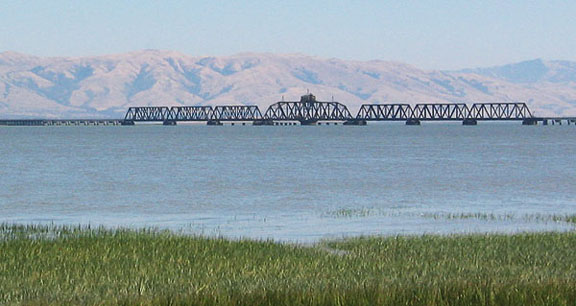

The existing Dumbarton Rail Bridge
will see revived rail service within a few years. A new bridge for
high speed rail would replace it if the Altamont Alignment is chosen.

|
The Altamont Alignment requires a new bay crossing at
Dumbarton, between Newark and East Palo Alto. This is the location of
the first bridge across San Francisco Bay, the Southern Pacific's
Dumbarton Bridge, built in 1910. The old bridge is owned by the San
Mateo County Transporation Authority. It will soon see a revival of
passenger rail service, with new commmute trains running between BART
in Union City and destinations on the Caltrain line.
Let's take a look at this statement. Without knowing the exact
age of the staff member, we'll assume he was born sometime after the
Bay and Golden Gate Bridges opened in the 1930's. From Caltrans'
site on Bay Area Toll Bridges: In 1956, the Richmond San Rafael Bridge opened. In 1958, the second Carquinez Bridge opened. In 1962, the Benicia Bridge opened. In 1967, a new San Mateo Bridge replaced the original span. In 1984, a new Dumbarton Bridge replaced the original span. In 2003, a second trestle was added to the San Mateo Bridge. In 2003, a new Carquinez Bridge replaced the original span. From my count, 7 bridges have been built across the bay in the
past 50 years.
A new bridge would cost billions.... CHSRA staff to Atwater City Council, October 16, 2003 A new Dumbarton rail bridge will cost no more than $200
million. The 6-lane highway bridge built at Dumbarton in 1984 cost $70
million. Using Caltrans'
Construction Cost Index to escalate the 1984 cost to 2004 dollars,
which sat at about 95 in 1984, and sits at 190 today (from
Caltrans), the index has doubled. This means that what cost $70m in
1984 would cost about $140m today. Allowing for an extreme variation in
costs due to added environmental safegards and mitigations today
relative to 1984, and ignoring that the 1984 highway bridge is 2.5
times the width of a high speed railway bridge, it is safe to assume
that $200m should be sufficent to build a new rail bridge at Dumbarton.
...look how complex the Bay Bridge project is.... CHSRA staff to MTC, May 9, 2003
Existing Dumbarton SR84 Bridge More discussion of the Bay Bridge project versus a new Dumbarton railway bridge.......... Discussion of wetlands impacts in the South Bay and Central Valley..... |
![]()